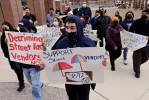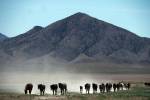For rodeo riders, injury risk is part of job description

Sean Willingham figures he’s racked up more than a half-dozen significant injuries during his bull riding career.
A skull fracture. Fractures of both his left and right collarbones. A shoulder dislocation. Two wrist fractures. An ankle fracture. Assorted broken ribs.
Oh, and not two weeks ago, Willingham underwent surgery for his second torn meniscus.
Those are Willingham’s significant rodeo injuries. What sort of less significant injuries has he suffered?
There’s a pause on the line.
And Willingham just laughs.
On Friday and Saturday , Willingham will be in Las Vegas to compete — yep, already — in the Professional Bull Riders’ Last Cowboy Standing competition at Mandalay Bay Events Center.
There, he will join a group of athletes who make medically perilous livings in a sport that — sorry football players, strongest man contestants and practitioners of mixed martial arts — is among the toughest around.
Seriously, unless you know of any MMA fighters who routinely go one-on-one against horned 2,000-pound opponents who couldn’t care less about rules or the ring of a bell.
While rodeo is a physically intense sport in general, some rodeo events account for more injuries than others. As a general rule, says Dr. Tandy Freeman, an orthopedic surgeon and medical director of the PBR’s sports medicine program, injuries tend to be more common in events in which the cowboy has comparatively less control over his ride.
According to the Justin Boots Sportsmedicine Team, which offers on-site medical care to pro rodeo athletes, bull riding accounts for about half of rodeo injuries, followed by bareback riding (about 23 percent) and saddle bronc riding (at about 16 percent).
Timed events, in contrast, account for fewer rodeo injuries. According to Justin, steer wrestling accounts for about 8 percent of rodeo injuries, followed by calf roping (about 3 percent) and team roping (about 1 percent).
But even timed events, which give the rider comparatively greater control over his ride, involve potentially risky elements. In calf roping, for example, “you’re going 35 miles an hour, bailing off of a 700-pound animal and hitting (the ground) hard,” Freeman says.
According to Justin, the most common injuries among rodeo riders are to the head and face (about 16 percent of injuries), knee and shoulder (about 12 percent each), and lumbar spine (about 8 percent).
But, long story short: Pick a body part, and a cowboy somewhere has broken it, shattered it, torn it, ripped it or dinged it.

Willingham, 31, has been competing in bull riding for about 17 years. What’s the appeal?
“Definitely it’s the adrenaline rush,” he answers by phone from his Georgia home. “And what’s great about bull riding is, every time you get on one, it’s different. It’s never the same feeling. All bulls do something different.”
Willingham’s worst injury so far was a skull fracture he received in Nebraska in 2001. He had just passed on his final year of college to turn pro and suffered the injury in his first-ever professional event.
“When I cracked my skull, I was out for four or five minutes, so I don’t know what happened, but I had to have surgery on my skull,” he says. That injury put him out of action for a full year.
Since then, “I’ve had a few concussions,” says Willingham, who now wears a helmet when he rides.
Then, Willingham once dislocated a shoulder when a bull threw him into the air.
“It doesn’t take much, especially when you get slammed by a large animal,” he says. “You come up at least 6 feet in the air, sometimes higher, (then) straight into the dirt.”
The ankle fracture, for which he had surgery in 2000, came when a bull stepped on him. It put him out of action for about four months.
“I rode him and he came down and it sounded like he just chopped me down,” Willingham says. “That was a bad one. I still have a plate and screw in there.”
The wrist fractures — both of which required surgery — came when he tried to break falls, while broken ribs are, he says, pretty much “normal.”
“You can’t really do much for ribs,” he says. “You just wrap them up.”
Freeman has been with the PBR for 19 years and also has been team physician for the National Basketball Association’s Dallas Mavericks. As PBR physician, he figures he sees many of the same sports injuries he’d see in any other sport.
“There’s nothing that happens in rodeo that doesn’t necessarily happen in the rest of the (sports) world,” he says. “We see ACL (anterior cruciate ligament, in the knee) tears, all sorts of sprained ankles, shoulder separations, all the same set of things we see in other sports.”
But in bull riding, he adds, “we see a lot of stuff you don’t necessarily see in other sports but would see in motor vehicle accidents or falls from high, that sort of thing: spine injuries, long bone fractures, chest and abdominal injuries.”
Already this year, “we had one guy who fractured a kidney and spent a week in the intensive care unit and may or may not go back to riding in six months,” Freeman says.
The kidney “pretty well just exploded,” he explains. “He got hit by a bull’s horn and he broke some ribs. It doesn’t appear any of the ribs pierced the kidney, but the impact split it in two.”
“That’s not something I ever saw in the NBA,” Freeman adds, and it’s the sort of injury that even “would be considered rare” in pro football.
Speaking of which: Like the National Football League, “we have a huge issue with concussions,” Freeman says. “Fifteen percent of injuries I look at are concussions, so that’s the most common thing.”
While the incidence of facial fractures has “decreased significantly” now that 50 to 60 percent of PBR riders wear helmets, the use of helmets has not altered significantly the incidence of concussions, Freeman says.
“That’s because, unfortunately, most of the time concussions are based on what happens inside the skull and not on what happens to the skull, so helmets don’t solve the problem.”
Willingham plans to compete this weekend at Mandalay Bay although the event will be barely two weeks after his knee surgery. He figures the repair was required mostly because of wear and tear — he also wakeboards and snowboards — but also because, during an event in Louisville, Ky., “I kind of landed real hard and kind of twisted my knee.”
Yet, he doesn’t consider it major surgery and figures to be ready “100 percent when I get to Vegas.”
One reason for Willingham’s determination to return so quickly surely is the cowboy ethic. More pragmatically — and unlike in other pro sports — if Willingham doesn’t compete, he won’t earn anything next weekend.
“The vast majority of guys are not going to make much money if they’re not actually there competing,” Freeman explains, a financial reality that can work to his disadvantage when trying to persuade an injured rider to take time off so that a serious injury might have time to heal.
As in most sports, learning proper technique can at least help to reduce the risk of injuries. For example, Willingham says, “you learn how to take a good fall.”
Ric Griffith, head coach of the University of Nevada, Las Vegas rodeo team, notes that many rodeo injuries result from improperly mounting or dismounting an animal.
“I have my bull riders get on just regular horses and practice getting off. It’s more of a balance thing,” he says.
Griffith says that, in a typical season, at least one UNLV rodeo team member will suffer a fairly significant injury that puts him or her out for the season. But the increased availability of protective gear — helmets and protective vests, for example — have increased riders’ chances of an injury-free season.
Still, the nature of bull riding means that it always will be a physically taxing sport. In the end, “it’s hard to mitigate the risk of injury in the sport,” Freeman says. “You can’t throw a flag and blow a whistle and expect (an animal) to stop.”
And that means competitors probably always will, to some degree, play hurt. Griffith says he tells his team members, “If you get a little bump on your whatever, you need to get over it or you’re in the wrong sport. It’s not for the weak-hearted.”
Does Willingham ever have to stifle a chuckle when he hears about a baseball player taking off a half-dozen games for, maybe, a hamstring pull? Not at all, he graciously answers, noting that baseball and bull riding are entirely different sports.
Even if, he adds with a laugh, “they do milk it a little longer than we would.”
Contact reporter John Przybys at jprzybys@reviewjournal.com or 702-383-0280.


















